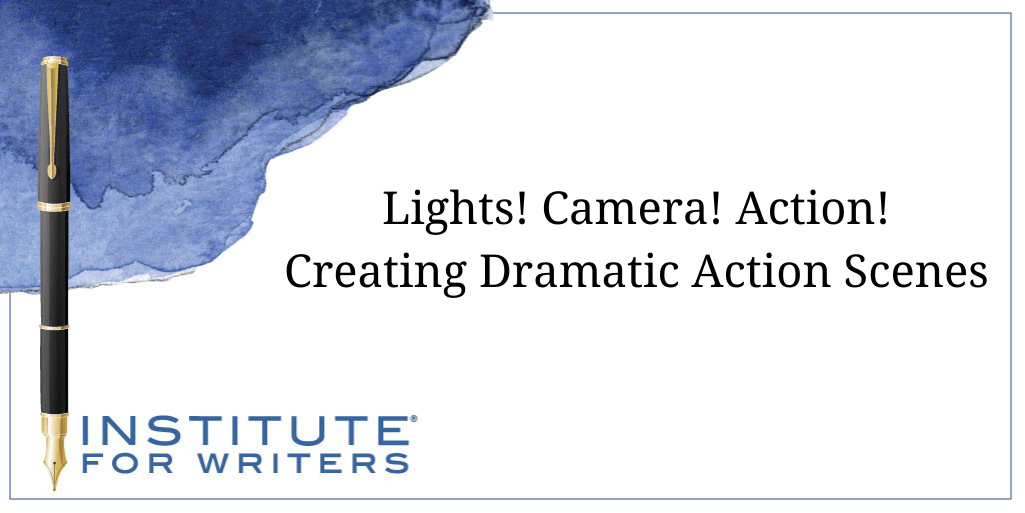
Why Submitting to Contests is a Win-Win
Should you enter a writing contest or not? If your writing rises to the top, you just might win a prize upwards of thousands of dollars if you’re lucky.

We teach our students how to write and get published!
View our Course Catalog >
It’s Back to School time! So, today we’re bringing you a sampling of the resources our students receive when they enroll in a course with IFW. Pointers from the Pros are 4-5 page articles that demonstrate a specific point about the craft of writing. If you’re stuck on a certain element in your writing (or writing assignment), as a student, you can download a related article to help you breakthrough that particular block. Today’s Pointer from the Pros comes from IFW instructor Kris Franklin and offers some excellent examples of how to show and not tell. Enjoy!
My first image of what would become my novel Relentless came into my mind during a mountain climb in southwestern Colorado. I’d gained an outcrop and stopped for water and a snack while I looked down into an alpine meadow dwarfed by distance. It was mid-September, a typically beautiful autumn day bright with the color of changing aspen. But what popped into my head was that same meadow buried under February snow—and a small, disabled private jet trying to land there . . . .
This beginning image was promising, but what I saw in my imagination was a long way from the reality of words on a page. How could I make this picture—this idea—come to life for a reader?
An absolute requirement for writing suspense stories—and this includes “mini- genres” like action/adventure, mysteries, and thrillers of any sort—is the ability to envision and write effective action sequences.
Here are two versions of an action sequence from Relentless. In this scene, lead character Nattie Kemper and her friend Ben McKee are fleeing from pursuing villains across a mountain meadow during a blizzard. The good guys are on a snowmobile; the baddies—well, you’ll see:
Nattie heard a noise above the sound of the wind. It was a helicopter. She heard Ben yell for her to go faster, and she realized someone was shooting at them from the chopper.
Plumes of snow blowing up on her left and then her right told her the shooter was trying to bracket the snowmobile, so she began evasive maneuvers from side to side. She smelled the snowmobile’s engine overheating and saw trees up ahead.
One of the shots hit the snowmobile and it veered to the right at the same time Ben told her the helicopter seemed to be going down. She concentrated on the trees, aware the snowmobile had begun to labor. Ben told her they were leaking oil . . .
And so on. Here’s the published version of the same scene:
Above the sound of the wind there was another noise behind them. The helicopter.
“Oh, Christ!” she heard Ben say.
Don’t look back. Don’t hesitate. Drive for the trees; they’re somewhere up ahead. Redline it . . .
Another noise. A whizzing sound.
“They’re shooting!” Ben wrapped his arms up over her shoulders. “Step on it, dammit!”
“What the hell do you think I’m doing?” she said in the split second before she realized he was
shielding her with his own body.
But there was no time to think of that right now. More whizzing sounds, a chorus of them, and a
plume of snow exploded just to her left.
Can’t let them get me bracketed.
She smelled the struggling little engine of the snowmobile overheating. She heard the steady
thwack-thwack of the ‘copter’s rotors above and behind her. Then off to one side . . .
And she saw the faint edge of something dark up ahead, swimming into her vision through the
blowing snow.
Trees.
Another zip of sound, so close she felt its heat . . .
As it smashed into the snowmobile next to her left knee. The Polaris jagged hard right on her,
and she fought for control. Pulled it back straight.
“Hey, I think . . . they’re going down!” Ben yelled. “Hot damn, they’re going down!”
Nattie didn’t look. She concentrated on the trees ahead. But she could no longer hear the noise
of the helicopter rotors above her. Just the howling of the wind . . .
And the ratchet, metal-on-metal sounds coming from the snowmobile’s engine.
God, no. “Come on, babe,” she whispered.
She throttled down to half-speed, but the grinding noises only got louder. “We’re leaking oil.” Ben leaned forward to speak into her ear. “Lots of it.”
The two versions are quite different, aren’t they? And that difference is as fundamental as the tried-and-true principle of show, don’t tell. Showing rather than telling is always a major element of good writing, regardless of the story.
It doesn’t matter if the story’s long or short, mainstream or one of many genre variations. When you tell your readers what happens, there’s often little to distinguish the writing from the story summary you may have assembled to provide yourself a roadmap or overview of the plotline. But when you show your readers what happens, the story comes to life, and that nasty bugaboo of all hardworking writers—the reader’s tendency to start skimming—is shoved out of the way, as it should be.
So even though show, don’t tell is universal to writing, the most dramatic examples of this principle are often found in action-dependent fiction such as suspense stories/thrillers.
In the first version of the scene, you do find out what happens. Nattie (the POV character) realizes the bad guys have taken to their helicopter in pursuit. They shoot at the snowmobile, and Nattie attempts evasive maneuvers. A bullet hits the snowmobile engine and it begins to lose power; at the same time, Nattie finds out the helicopter’s also in trouble.
Fair enough. That’s exactly what happens. But in the first version (the telling version), we might as well be reading about it in a newspaper. In the second version (the showing version), we’re pulled into the action and into the emotions of our viewpoint character. Part of the reason for this is dialogue.
Dialogue can be external, as in the actual words spoken by Nattie and Ben, but it can also be internal, as when we read Nattie’s thoughts. In both instances, well- written dialogue is a key component of the show, don’t tell principle, and therefore of most action scenes as well.
Let’s go back to the action sequence. Nattie is thinking: Don’t look back. Don’t hesitate. Drive for the trees; they’re somewhere up ahead. Redline it . . .
Is this something she’d be saying out loud? Of course not; she’s clearly thinking these things, but they constitute dialogue nonetheless. The use of italics instead of quotation marks is one way, along with the context itself, to distinguish internal dialogue.
It’s equally important for both internal and external dialogue to be true to the “voice” of the character. By this time, we know Nattie; we know how she talks and, since we’re in her point of view for much of the story, we know how she thinks. Using internal dialogue allows a writer go deeper into that level of characterization as well.
Another simple but sometimes overlooked component of an action sequence is the value of a quick pace, achieved by creating a series of kinetic pictures in a reader’s mind. One of the easiest ways to achieve this is by using short “burst” sentences and short paragraphs.
Here’s an excerpt from the first sample scene (telling):
One of the shots hit the snowmobile and it veered to the right at the same time Ben told her the helicopter seemed to be going down.
Now the same plot event from the second excerpt (showing):
. . . The Polaris jagged hard right on her, and she fought for control. Pulled it back straight.
Technically, that last sentence is a fragment lacking a subject noun, but here it’s the feeling, the emotion, that’s important. In action sequences, quick sentence fragments like this (as long as the context is understood) can help to provide that sense of motion, of something happening right now! In fact, in hindsight, I might make that excerpt three sentences instead of two:
. . . The Polaris jagged hard right on her. She fought for control. Pulled it back straight.
In the sample scenes, we’re in Nattie’s narrow (or limited) POV. This means we can only show what she knows when she knows it. If we step outside of Nattie’s perspective, we’ll lose the sharp focus we need, and compromise believability (essential in pulling readers out of their own perspectives and into the minds of our characters). We understand that Ben’s view of all this may be slightly different, and in fact we’ll be seeing things from his POV during other scenes, but right now it’s all Nattie, all the time.
She hears the helicopter, so we hear it, too, along with Ben’s verbal responses. As Nattie hears the bullets and sees them burst up snow plumes on both sides of the snowmobile, we do too. With her, we smell the engine overheating, we see the promise of temporary safety in the trees, and we hear Ben’s words about the ‘copter beginning to struggle. But the trees are still distant, and the snowmobile’s fatally wounded . . .
An omniscient (all-knowing, all-seeing) viewpoint could tell us—and to some extent, show us—the same things, but it would lack the immediacy and emotion of experiencing events through our lead character’s senses. Immediacy and emotion, and a visceral tugging at our own senses, are like dialogue and pace: they’re key elements of an effective action scene and even apply to quieter scenes.
Be careful, though, not to overwhelm your reader with too many sensory impressions at the same time. Here’s Nattie, alone with her thoughts after a brutal day. Note that only one sense is used, but it works to set the tone for Nattie’s mood:
The wind screamed at her from outside, and it was the sound of emptiness. Of loss . . .Of loneliness. A life alone. Always afraid and always fighting her solitary war against that fear. Conquering it in small, hesitant steps. Alone.
You fall down, pick yourself up, Nattie. You get knocked down, pick yourself up again.
And go on. Alone.
This scene is introspective, with no action in the generally accepted sense. It uses internal dialogue for that reason, but the keys are the immediacy of a reader’s connection to this character, and the emotion generated because the reader identifies with Nattie.
I’m not sure how long I sat on that outcrop overlooking the meadow—probably not long, because it wasn’t the best place to stop—but by the time I moved up the rock face, I already had the broad strokes of the story in my mind. Now I needed to put my plan into action.
Try these tips for engaging your reader:
• Show, don’t tell.
• Include internal and external dialogue.
• Stay true to the viewpoint and voice of your main character.
• Pace the action to reflect the intensity of each scene.
• Use short “burst” sentences (and fragments) and short paragraphs.
• Use your character’s senses to fully engage your reader with immediacy and emotion.
If this is the level of detail you’d to see in critiques on your work, get started in one of our courses today by taking our Writing Assessment. Just click here.
After a lengthy teaching career, Kris Franklin began freelancing with outdoor/fitness articles and stories, often built around humor. This led to a newspaper job writing features and then to his own humor column. His published work includes short form fiction, nonfiction articles and essays, and three suspense novels set in the Colorado mountains where he lives. Kris is a writing instructor for the Institute for Writers.

Should you enter a writing contest or not? If your writing rises to the top, you just might win a prize upwards of thousands of dollars if you’re lucky.

To many, writing is revision, and most writers revise their manuscripts numerous times before they’ve shaped it into the best version that it can be.

We’re going to look at influential female authors of the past, those impacting the present, and whom the industry expects to make a big splash.
1000 N. West Street #1200, Wilmington, DE 19801
© 2024 Direct Learning Systems, Inc. All rights reserved.
1000 N. West Street #1200, Wilmington, DE 19801
© 2024 Direct Learning Systems, Inc. All rights reserved.
1000 N. West Street #1200, Wilmington, DE 19801
© 2024 Direct Learning Systems, Inc. All rights reserved.
1000 N. West Street #1200, Wilmington, DE 19801
© 2024 Direct Learning Systems, Inc. All rights reserved.

1000 N. West Street #1200, Wilmington, DE 19801
© 2025 Direct Learning Systems, Inc. All rights reserved.

1000 N. West Street #1200, Wilmington, DE 19801
©2025 Direct Learning Systems, Inc. All rights reserved. Privacy Policy.
1 Comment